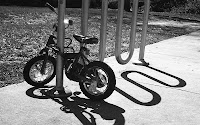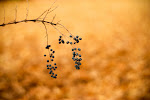
Before a few weeks ago, the only film I'd ever used was in the 110 format mini camera I used as a kid, and an advantix camera that kicked around in my sock drawer during college. I recently used a 35mm film camera for the first time, a generous family hand-me-down.
I recognize I'm behind the times by a few decades - those with lots of film experience might want to stop reading now. But I'd bet there's other folks out there who have never used film for anything other than family snapshots.
Going out and taking pictures felt very different - since there's a cost associated with pressing the shutter, I was much more careful about what I photographed. With my digital camera, it's really, really easy to stroll with my camera and come home with 100+ pictures - few of which I might actually like.
Rather than taking fistfuls of pictures of a given subject, I was more likely to study it for a bit longer, and just take one or two. I was pleased by the results - when the film came back from the lab, most of the pictures looked how I'd hoped they would.
Not being able to see the results is weird, but easy to adapt to. After taking lots of pictures with digital cameras on manual, using a manual film camera isn't *that* different - I just had to trust my guesses. I had a point & shoot digital camera with me (to use as a light meter), but I tried not to use it.
I shot one roll of Velvia slide film, and one roll of Tri-X, a classic Black and White film. Some of the color slides came out OK, but I really liked the classic look of the Tri-X film. Shooting in black and white forced me to look for different sorts of pictures. Under the bright sunlight, it also felt more flexible - I didn't need to worry about flat color, and the sharp, dark shadows felt more like compositional elements rather than hindrances.
If you're interested, you can check out the results here.
If you've only shot digital, I'd recommend trying it out. Shooting a couple rolls isn't that expensive, and there are loads of decent film cameras out there to be had on the cheap. I'm sure there are other folks in the group who could steer anyone who was interested in the right direction.
